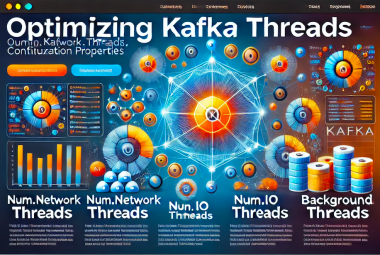Apache Kafka is a powerful distributed streaming platform that enables the creation of real-time data pipelines and streaming applications. Ensuring high availability and fault tolerance is essential when setting up Kafka clusters. One effective strategy to achieve this is through rack awareness. In this blog, we'll explore the concept of rack awareness in Kafka, its benefits, and how to configure it correctly. We'll also include architecture diagrams to provide a clearer understanding of these concepts.
What is Rack Awareness in Kafka?
Rack awareness in Kafka helps distribute replicas of partitions across different racks within a data center. A rack consists of servers sharing common infrastructure like power or network switches. By ensuring that replicas of the same partition are not placed in the same rack, Kafka can withstand rack-level failures without compromising data availability.
Benefits of Rack Awareness
- Enhanced Fault Tolerance: If a rack fails due to network or power issues, Kafka continues to operate because replicas are stored in other racks.
- Improved Data Durability: Distributing replicas across racks reduces the risk of data loss.
- Optimized Resource Utilization: Rack awareness helps balance the load and ensures better resource utilization across the data center.
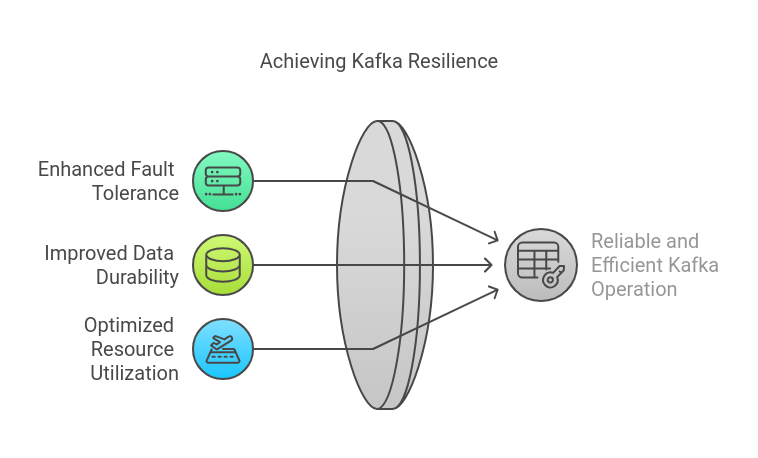
Problems of Not Having Rack Awareness in Kafka
When rack awareness is not configured in a Kafka cluster, several issues may arise that can compromise the reliability and availability of your system:
- Single Point of Failure: If replicas are not distributed across racks, a rack-level failure can lead to data unavailability or downtime. For instance, if all replicas of a partition are placed in the same rack, losing that rack will make the partition unavailable.
- Increased Risk of Data Loss: Without rack awareness, a catastrophic failure like a power outage or switch failure in a rack can lead to the loss of all replicas for a partition, resulting in data loss.
- Uneven Load Distribution: Lack of rack-aware configuration can lead to uneven resource utilization. This might cause hotspots where certain racks experience high traffic, while others remain underutilized.
- Difficulty in Scaling: Scaling a cluster without rack awareness can lead to inefficient replica placement, causing issues with balancing partitions and replication across the cluster.
Configuring Rack Awareness in Kafka
Follow these steps to configure rack awareness in Kafka:
- Assign Rack Information to Brokers: Each Kafka broker needs a rack ID. Set the broker.rack property in the server.properties file for each broker.
broker.rack=<rack-id>- Configure Topic Replication: When creating a topic, specify the replication factor and the placement of replicas. Kafka uses rack information to distribute the replicas.
- Enable Rack Awareness in Kafka: Set the
replica.selector.classproperty in the Kafka configuration toorg.apache.kafka.common.replica.RackAwareReplicaSelector.
replica.selector.class=org.apache.kafka.common.replica.RackAwareReplicaSelector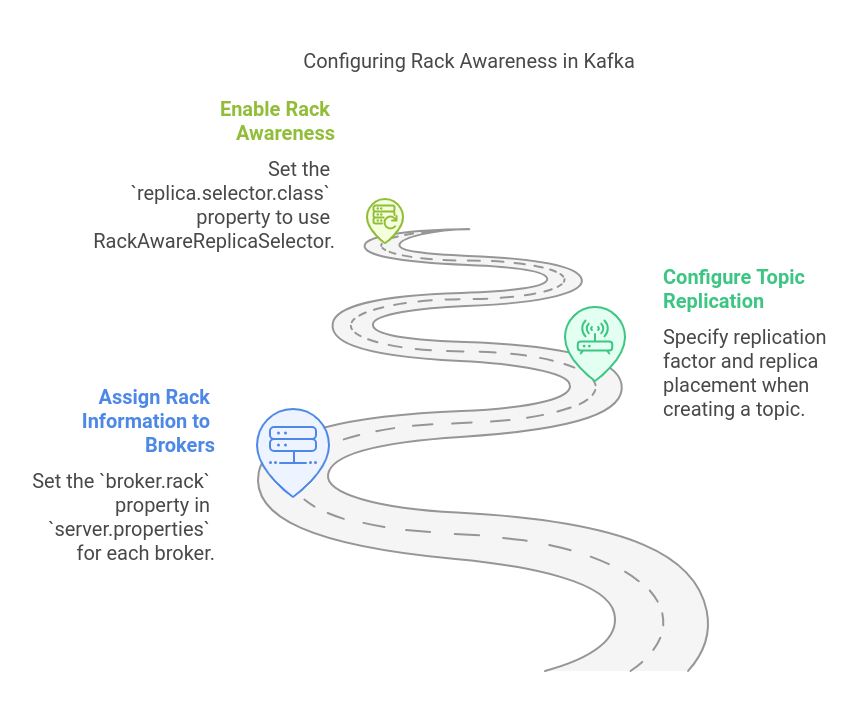
Example Configuration
Consider a Kafka cluster with six brokers distributed across three racks: rack1, rack2, and rack3. Here’s how you might configure rack awareness:
Assign Rack IDs to Brokers:
- Broker 1, 2: rack1
- Broker 3, 4: rack2
- Broker 5, 6: rack3
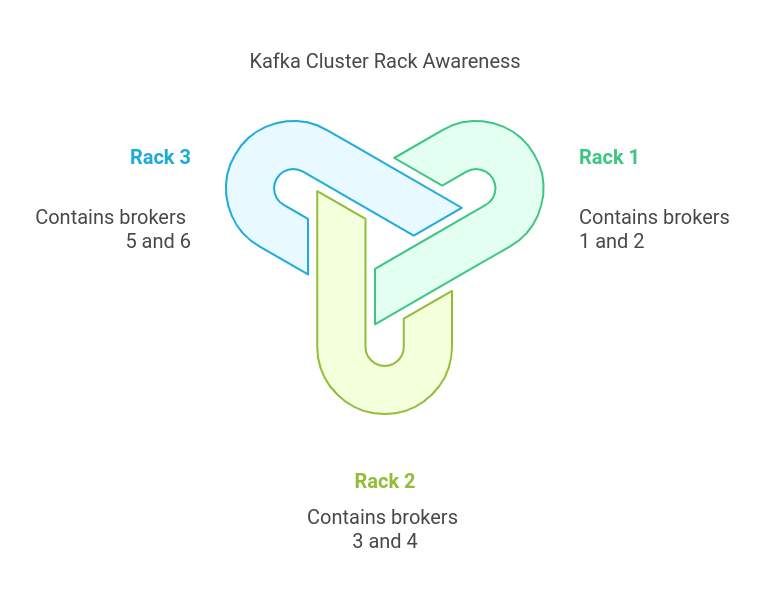
Configure server.properties for Each Broker:
# For Broker 1
broker.rack=rack1
# For Broker 2
broker.rack=rack1
# For Broker 3
broker.rack=rack2
# For Broker 4
broker.rack=rack2
# For Broker 5
broker.rack=rack3
# For Broker 6
broker.rack=rack3
Enable Rack Awareness:
replica.selector.class=org.apache.kafka.common.replica.RackAwareReplicaSelectorArchitecture Diagram
To better understand this configuration, here's a visualization of the Kafka cluster architecture with rack awareness:
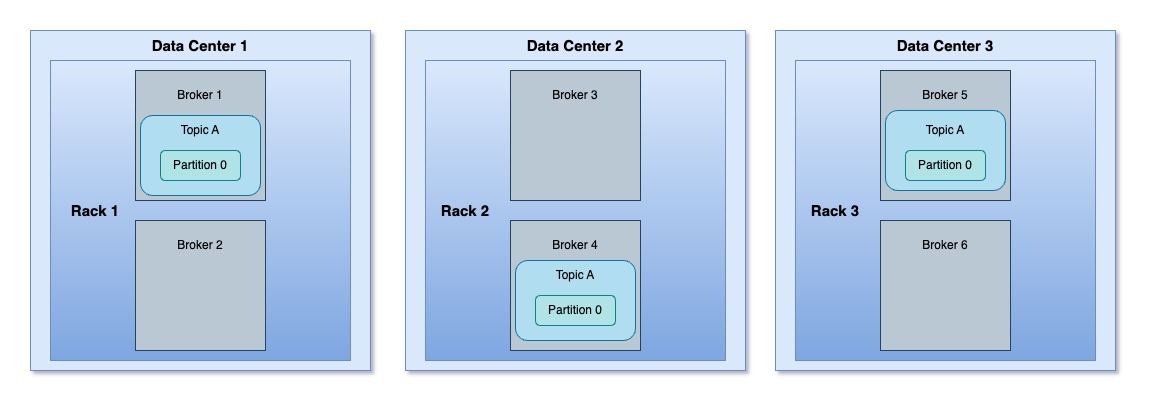
Conclusion
Rack awareness in Kafka is a powerful feature that significantly enhances the fault tolerance and reliability of your Kafka clusters. By carefully configuring rack IDs and enabling rack-aware replica placement, you can ensure that your data is resilient to rack-level failures, maintaining high availability and durability.
With this configuration, your Kafka cluster is better equipped to handle data center-level disruptions, providing a robust foundation for your streaming data applications.



